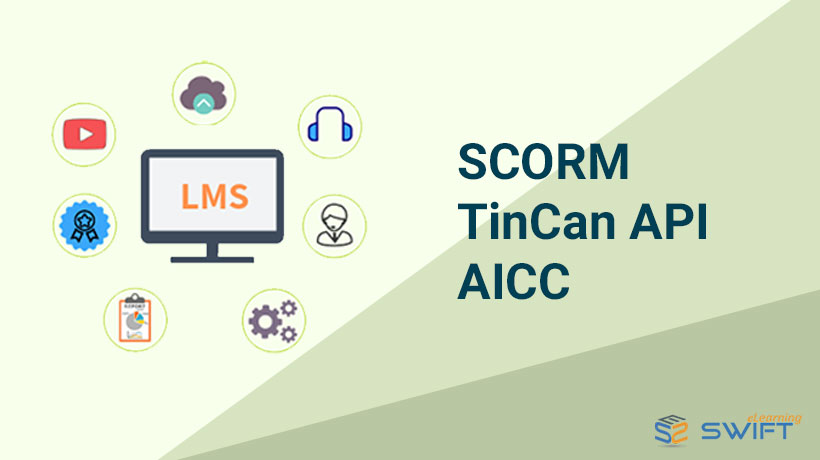SCORM:
SCORM is a set of standards for eLearning content that ensures compatibility and interoperability, allowing online courses to be easily shared across different learning platforms.
SCORM stands for Sharable Content Object Reference Model which is actually a technical standard for writing e-learning content. It is highly popular and is an industry standard which allows organizations to use e-learning as a training method. Basically, SCORM will decide how online content and the Learning Management System (LMS) will talk to each other. SCORM uses a JavaScript API (Application Programming Interface) to communicate information between the course content and the LMS.
Key Features of SCORM:
Interoperability: SCORM ensures that content created on one SCORM-compliant platform can be used seamlessly on another.
Tracking and Reporting: SCORM allows detailed tracking of learner progress, completion, and assessment scores.
Sequencing: It enables the organization of learning content in a sequential manner, controlling the flow of the course.
What can you achieve by using SCORM?
Durability: Content developed using SCORM will survive technological changes without expensive re-coding or re-design.
Accessibility: SCORM courses are portable and run on any standard SCORM compatible LMS.
What could be the advantage of using SCORM?
We have a plethora of advantages when it comes to SCORM. Let us highlight few here:
- Easy integration and sharing across platforms which protects investments and significantly lowering the cost of content ownership.
- “Sequencing” is an added feature introduced in SCORM 2004, which can actually assign a sequence to a learning object which would permit learners to bookmark their progress.
- Detailed tracking of reports on a learning object is possible.
Any disadvantages with SCORM?
There is a very wrong side to the bright side of SCORM. Let us list down some disadvantages too:
- There are issues that exist with scripting across browsers
- Content and LMS must reside on the same server
- SCORM content uses JavaScript which is not very secured.
AICC:
AICC, or Aviation Industry Computer-Based Training Committee, is a standard in aviation for computer-based training (CBT). It specifies how eLearning content communicates with the learning management system (LMS).
The Aviation Industry CBT Committee (AICC) standard uses HTTP messages to communicate to the LMS (while SCORM communicates with JavaScript). Established in 1993, this standard focused more on CD-ROM delivery methods and Web based training was added later in 1998. Uploading content to an LMS using AICC is typically a multiple step process.
What could be the advantage of using AICC?
- Content can be stored in a separate server, which allows more secure transfer of information using HTTPS protocol.
Any disadvantages with AICC?
- Data structure is very complicated.
Here is the bad news. In 2014, the AICC (committee) decided to dissolve due to decline in membership numbers. We need to acknowledge the fact that AICC paved the way for standardizing the interoperability of elearning content. That said, it won’t mean it’s the demise of AICC content. Many companies still have older content still remaining among their training materials that was originally packaged in AICC. This is still being used.
Tin Can API, xAPI or Experience API:
Tin Can API, xAPI or Experience API, is a technology that tracks and records learning experiences, providing a more comprehensive and versatile approach to learning data than traditional eLearning standards.
Welcome to the 21st century folks. Learning is an experience now. It can happen through blog, video nuggets, presentations or through wiki, anywhere and everywhere. This new era recognizes the importance of informal learning in a way that was never done before. We need to acknowledge the fact that various media is contributing to a learner who is acquiring knowledge.
So, what is TIN CAN then?
Tin Can API or Experience API (rightly said!!!) helps organizations to track this informal learning. It has this unique concept called Learning Record Store (LRS) which will collect both online and offline data about different kinds of learning experiences that a learner has.
What could be the advantage of using TIN CAN?
- The scope of learning goes beyond the confines of a traditional LMS.
- Employees have a reason now to feel more motivated and pursue a more diverse set of learning activities, knowing well that they are going to be recognized among peers.
- For organizations who are now aiming at Mobile learning, Tin Can API is the way forward. It takes full advantages of all the features (accelerometer, compass, camera, GPS, magnetometer, gyroscope, etc.) present in a mobile to provide you a gamut of options that could be used to the user’s advantage.
- Blended Learning is easier to accomplish.
We are here to support you in creating custom eLearning courses.
Click here to share your requirements, and we will respond to you instantly.
The Verdict:
Which of these standards should you consider when looking for your corporate LMS solution? Well, it depends! Many organizations look for product maturity (which is a safe choice) and they go with SCORM. Tin Can is the new kid on the block and is more of a luxury add-on if you want to go with a “rich” learning experience. So, choosing an LMS system is about decision making regarding what content can be played or hosted by the tools. Things like interactivity, richness of the eco system, scalability, security, and global acceptance must also be weighed.




